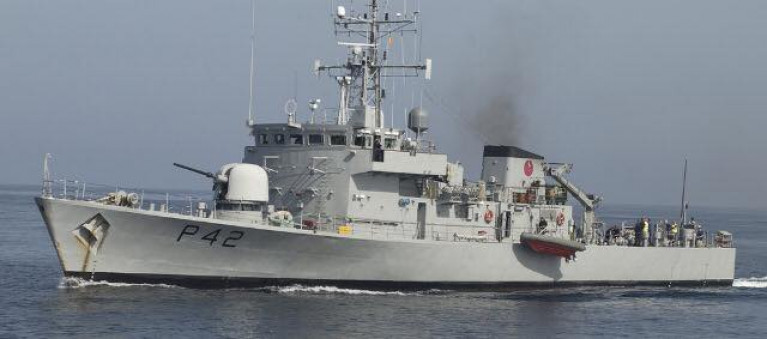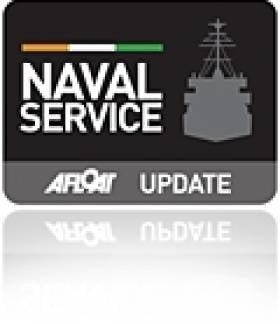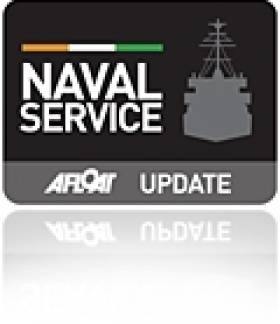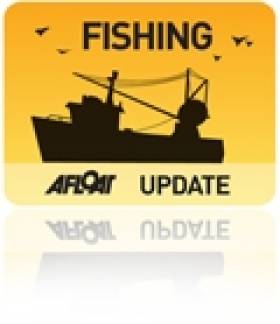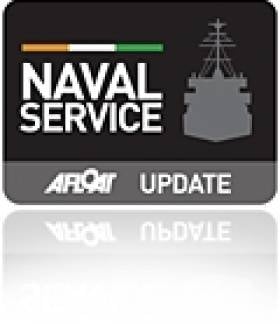Displaying items by tag: LE Ciara
Farewell LE Orla (P41) and LE Ciara (P42) as Navy Vessels Depart Cork Harbour for Scrapping
On Sunday afternoon, Cork Harbour was poignantly reminded of passing times as the now decommissioned LE Orla (P41) and LE Ciara (P42) were led out of their home port for the last time, heading overseas for disposal at a scrap recycling facility.
Both Peacock-class patrol vessels have been in service with the Irish Naval Service around the Irish coast since 1989.
As Afloat reported in December 2023, the decommissioning of the 712-tonne sister ships was partly due to their age, coincidentally all built in 1984; in addition, the vessels were taken out of service due to the ongoing crewing crisis that has impacted the service, which has led to not enough sailors to crew all its ships.
A Port of Cork pilot boat escorted the ships out of Cork Harbour in a relatively calm sea, with tugs fore and aft.
 LE Orla (P41) and LE Ciara (P42) depart Cork Harbour
LE Orla (P41) and LE Ciara (P42) depart Cork Harbour
Gardaí are investigating an incident where a body was recovered offshore from Dun Laoghaire Harbour, on Dublin Bay yesterday, (Friday, 9th October).
The Naval Service's coastal patrol vessel LÉ Ciara (P42) assisted with the recovery of the body.
The body of the deceased was taken to the local mortuary and, according to a Navy spokeswoman, the incident is now a matter for an Garda Siochana.
Enquiries are ongoing and there is no further information at this time, according to a Garda spokeswoman.
As Afloat reported yesterday, LE Ciara arrived into Dun Laoghaire Harbour yesterday at lunch-time, berthed overnight at number four berth and departed this morning (Saturday, October 10th).
Local sources told Afloat the body was of a female and was recovered well offshore but this was not confirmed.
Staff Shortage May See Naval Service Ship Tied Up While Ireland ‘Awash with Drugs’
There are fears that the Naval Service due to under-resources won’t be able to combat maritime drug shipments while at the same time adequately patrolling EU fishery waters post-Brexit.
As the Irish Examiner reports, concerns have also been raised that it may have to tie up yet another ship, due to debilitating manpower shortages.
RACO, the organisation that represents the country’s military officers, said that despite tying up LÉ Eithne and LÉ Orla last June, the manpower crisis is deepening by the day and “there are concerns that the tying-up of a further ship could be imminent”.
The RACO general secretary, Commandant Conor King, said it is worrying that even the remaining ships “are routinely operating on the edge of the minimum workable crewing numbers”.
He pointed out that LÉ Ciara was on sailing order on December 30, but failed to leave port (as previously reported) until January 1 due to illness/injury of crew members.
More on the story can be found here.
Delayed Mission In Naval Service Due to Lack of Crew
A delay in the deployment of a patrol ship for three days recently was forced upon the Naval Service because it could not find the minimum number of sailors required.
The patrol vessel LÉ Ciara, writes The Irish Times, is supposed to have 39 crew but in late December it had a crew of only 34, the minimum number of sailors required to safely operate the ship.
By the time it received orders to set sail from Haulbowline Naval Base on December 30th on a routine maritime defence and security operations patrol, two of its crew had reported in sick.
This meant LÉ Ciara was unable to sail because it did not have what is known as the “damage control and fire fighting bubble”, ie it did not have enough crew to safely deal with fires or other emergencies if they occurred.
It remained in port for three days while replacement crew were found. The ship was eventually able to depart on its mission on January 1st.
For more on the detention crisis click here.
#Asbestos – While carrying out routine maintenance of a Naval Service patrol vessel, it is now being claimed that 30 more civilian workers could also have been exposed to potentially lethal asbestos, writes The Irish Examiner.
That's in addition to another seven naval personnel who also have been exposed to the dust while they were working on the LÉ Ciara (P41) at the navy's headquarters in Haulbowline, Co Cork, last month.
The crisis deepened last night when Siptu said none of its civilian worker members, who are employed by the Department of Defence, had yet received any medical assessment — unlike the Naval Service personnel. To read much more on this story, the Irish Examiner has a report.
Search Scaled Down for Missing Crewman in Irish Sea
#RESCUE - BBC News reports that the search for a cargo ship crewman missing in the Irish Sea has been scaled down.
The 22-year-old from Slovakia was reported missing yesterday morning from the Fehn Sirius, which was en route from Belfast to Portugal, as it headed past Arklow, Co Wicklow.
According to The Irish Times, he was last seen on the cargo ship around 10pm on Monday night as it headed south of the entrance to Strangford Lough.
Lifeboats from Portaferry and Newcastle in Northern Ireland and Arklow joined the search and rescue operation, which was assisted by the RAF helicopter based at Prestwick in Scotland and an Irish Coast Guard helicopter.
However, most rescue services have now been stood down as the Fehn Sirius continues to backtrack in the Irish Sea, with assistance from the Naval Service vessel LE Ciara.
Only three days ago the body of another mariner was recovered from the Irish Sea off the north Dublin coast, more than a month after he went missing.
LE Ciara Returns to Sea after Hull Repairs
#NAVAL SERVICE- The Naval Service patrol ship LE Ciara (P42) has been cleared to return to sea, following repairs to a hole in its hull, the Irish Times reports.
The high-speed coastal patrol vessel (CPV) is the latest in a series of vessels in the fleet which have required substantial repair due to a combination of age and rough Atlantic conditions.
The oldest ships of the eight-strong fleet, the sisters LE Emer , Aoife and Aisling , have all suffered plate erosion due mainly to age. The service is due to received two new ships at €50 million each, which will be commissioned in 2014 and 2015, under a deal with British shipbuilder Babcock Marine.
Following inspection of the vessel's papers, the vessel was detained and was escorted to Rosslare at approximately 1am on the morning of Friday 5th August. Sea-Fisheries Protection Officers undertook an investigation and valuation of the catch and fishing gears onboard the vessel. Legal proceedings involving An Garda Siochana and the SFPA were initiated on the 5th August in Rosslare against the Master of the vessel.
Peter Whelan, Chairman of the SFPA said: "The illegal landing of fish only serves to depress the price the legitimate fisherman should be achieving for fish. It also distorts the markets and only serves to benefit those involved in illegal fishing activity. Licensing and authorisation of fishing vessels is a basic perquisite of EU and Irish law. The role of the SFPA supports profitable, sustainable, managed fisheries at a time when the fishing industry faces many challenges. Effective monitoring and control systems safe-guards the good reputation of Irish food producers in the international marketplace and protects Irish taxpayer from the threat of large fines being imposed when non-compliances with the Common Fisheries Policy are encountered."
Navy’s Night-Time Detention of Belgium Fishing Vessel
In March another foreign-flagged fishing vessel, the UK registered Lynn Marie was detained on the same grounds for an alleged breach of fishing regulations by the L.E. Orla (P41). The Lynn Marie was escorted by the Peacock –class coastal patrol vessel (CPV) into Dun Laoghaire Harbour and similarly the custody of the vessel was transferred to the Gardai.
So far this year the Naval Service has carried out 852 boarding's and eight detentions of vessels off the Irish coast. In 2010 the navy conducted 1666 boarding's which resulted in warnings to 70 vessels and eight detentions.
Navy Escort Detained Trawler to Castletownbere
Less then a month ago the Naval Service detained a Northern Irish registered fishing vessel the Lynn Marie seven miles east off Bray Head. Onboard was a crew of 4 UK nationals who were taken into custody to the Gardai after the trawler was escorted by the CPV L.E. Orla to Dun Laoghaire Harbour. To read more about this detention click here.
Ironically the L.E. Orla was a former Royal Naval vessel, HMS Swift (P241) which was deployed on her first assignment to the Hong Kong Patrol Squadron for a four-year period. In 1988 Margaret Thatcher's Conservative Party Government disposed HMS Swift and HMS Swallow (P242) to the Irish Naval Service. The pair were built by Hall Russell Shipyard of Aberdeen as part of an eight 'Peacock' class coastal patrol vessel (CPV).
The 'Peacock' pair were commissioned into the Naval Service and renamed L.E. Orla (P41) and L.E. Ciara (P42) in a ceremony attended by An Taoiseach Charles J. Haughey at the Naval Base in Haulbowline, Cork Harbour.
This weeks' detention is the second conducted by the Naval Service in 2011. Last year the Naval Service carried out 1,666 vessel boardings which resulted in 70 warnings and eight detentions.
- Irish Naval Service
- Cork Harbour
- Northern Ireland
- Haulbowline
- castletownbere
- naval service
- LE Niamh
- Royal Navy
- Ports and Shipping News
- Lynn Marie
- Fishery Breaches
- Fishery Detention
- Fishing Trawler
- Peacock Class
- Hong Kong
- Hall Russell
- Appledore Shipbuilders
- LE Orla
- HMS Swift
- LE Ciara
- HMS Swallow
- Margaret Thatcher
- Conservative Party
- An Taoiseach
- Charles J. Haughey
- Naval Base




























